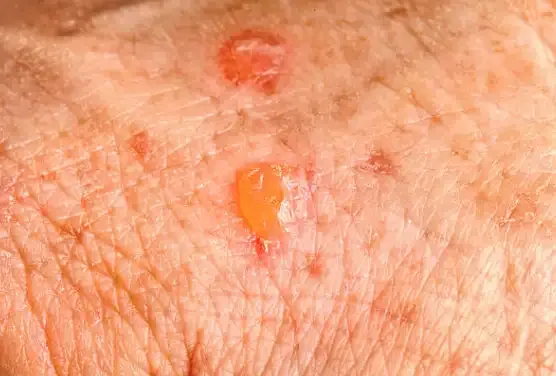Actinic keratosis, also known as solar keratosis, is a common skin condition characterized by dry, scaly patches that have been damaged by the sun. While actinic keratosis is usually not serious, there is a small chance that these patches could develop into skin cancer. In this article, we will explore the causes, symptoms, and treatment options for actinic keratosis.
What is Actinic Keratosis?
Actinic keratosis is a precancerous skin condition that occurs as a result of long-term sun exposure. It most commonly affects areas of the body that are frequently exposed to the sun, such as the face, hands, arms, scalp, ears, and legs. The patches of actinic keratosis can vary in size, ranging from 1cm to 2cm. They may appear dry, rough, and scaly, resembling sandpaper. The color of the patches can range from pink to red to brown, and they may be itchy.
Causes of Actinic Keratosis
The primary cause of actinic keratosis is prolonged exposure to the ultraviolet (UV) rays of the sun. Over time, these rays can damage the DNA in the skin cells, leading to the development of the patches. Fair-skinned individuals, people with a history of frequent sunburns, and those with a weakened immune system are at a higher risk of developing actinic keratosis.
Symptoms of Actinic Keratosis
In the early stages, actinic keratosis may not cause any noticeable symptoms. However, as the condition progresses, the patches may become more visible and start to exhibit certain signs. It is important to be aware of these symptoms and seek medical attention if you experience any of the following:
- New Patches: If you notice new patches of dry, scaly skin on your body, particularly in sun-exposed areas, it could be a sign of actinic keratosis.
- Changes in Color, Size, or Texture: Actinic keratosis patches may change in color, size, or texture over time. If you observe any such changes, it is recommended to consult a healthcare professional.
- Bleeding or Tender Patches: Patches that begin to bleed, feel tender, or develop into a lump should be evaluated by a medical expert.
- Lip Involvement: Actinic keratosis can also affect the lips. If you notice a patch on your lips, it is essential to have it examined by a healthcare provider.
Diagnosis of Actinic Keratosis
If you suspect that you may have actinic keratosis, it is important to see a healthcare professional for a proper diagnosis. During the examination, the healthcare provider will assess the appearance of the patches and inquire about any symptoms or changes you have noticed. In some cases, a skin biopsy may be performed to confirm the diagnosis.
Treatment Options for Actinic Keratosis
The treatment of actinic keratosis aims to remove the patches and prevent them from developing into skin cancer. The appropriate treatment option will depend on various factors, including the number and size of the patches, their location, and the individual's overall health. Here are some common treatment methods:
- Prescription Creams and Gels: Topical creams or gels containing ingredients such as imiquimod, fluorouracil, or diclofenac can be applied directly to the affected areas. These medications help to destroy the abnormal cells and stimulate the growth of healthy skin.
- Cryotherapy: Cryotherapy involves freezing the patches with liquid nitrogen. This causes the patches to blister and eventually fall off. It is a commonly used treatment option, particularly for multiple patches.
- Surgery: In some cases, surgical procedures may be necessary to remove the patches. This can involve cutting out the patches or scraping them away. Local anesthesia is administered to ensure a painless procedure.
- Photodynamic Therapy (PDT): PDT involves applying a special cream to the patches, which makes them more sensitive to light. A specific light is then shone on the patches, which activates the cream and destroys the abnormal cells.
It is important to note that the choice of treatment will be determined by your healthcare provider based on the specific characteristics of your condition.
Prevention of Actinic Keratosis
Preventing actinic keratosis is essential to minimize the risk of developing skin cancer. Here are some preventive measures you can take:
- Regular Skin Checks: Perform regular self-examinations of your skin to check for any new or changing patches. If you notice anything unusual, consult a healthcare professional.
- Sun Protection: Protect your skin from the harmful effects of the sun by wearing sunscreen with a sun protection factor (SPF) of at least 30. Apply it generously before going outdoors and reapply it regularly.
- Cover Up: Wear protective clothing, such as hats and clothing that covers your arms and legs, to shield your skin from direct sun exposure.
- Avoid Sun Exposure: Limit your time in the sun, especially between 11am and 3pm when the sun's rays are the strongest.
- Avoid Tanning Beds: Avoid using tanning beds or sunlamps, as they can also cause damage to your skin.
Conclusion
Actinic keratosis is a common skin condition that can be caused by long-term sun exposure. While it is not usually serious, it is important to monitor any changes in the patches and seek medical attention if necessary. Treatment options for actinic keratosis include prescription creams, cryotherapy, surgery, and photodynamic therapy. By practicing sun protection and taking preventive measures, you can reduce the risk of developing actinic keratosis and skin cancer. Remember to consult a healthcare professional for an accurate diagnosis and personalized treatment plan.

